An Introduction to Cryptography
Mohamed Barakat, Christian Eder, Timo Hanke
September 20, 2018
�
�
Preface
Second Edition
Lecture notes of a class given during the summer term 2017 at the University of Kaiserslautern. The
notes are based on lecture notes by Mohamed Barakat and Timo Hanke [BH12] (see also below).
Other good sources and books are, for example, [Buc04, Sch95, MVO96].
Many thanks to Raul Epure for proofreading and suggestions to improve the lecture notes.
First Edition
These lecture notes are based on the course “Kryptographie” given by Timo Hanke at RWTH Aachen
University in the summer semester of 2010. They were amended and extended by several topics,
as well as translated into English, by Mohamed Barakat for his course “Cryptography” at TU Kaiser-
slautern in the winter semester of 2010/11. Besides the literature given in the bibliography section,
our sources include lectures notes of courses held by Michael Cuntz, Florian Heß, Gerhard Hiß and
Jürgen Müller. We would like to thank them all.
Mohamed Barakat would also like to thank the audience of the course for their helpful remarks
and questions. Special thanks to Henning Kopp for his numerous improvements suggestions. Also
thanks to Jochen Kall who helped locating further errors and typos. Daniel Berger helped me with
subtle formatting issues. Many thanks Daniel.
i
�
Contents
Second Edition . . . . . . . . . . . . . . . . . . . . . . . . . . . . . . . . . . . . . . . . . . . . . .
First Edition . . . . . . . . . . . . . . . . . . . . . . . . . . . . . . . . . . . . . . . . . . . . . . . .
Contents
1 Introduction
2 Basic Concepts
2.1 Quick & Dirty Introduction to Complexity Theory . . . . . . . . . . . . . . . . . . . . .
2.2 Underlying Structures . . . . . . . . . . . . . . . . . . . . . . . . . . . . . . . . . . . . . .
2.3 Investigating Security Models . . . . . . . . . . . . . . . . . . . . . . . . . . . . . . . . .
3 Modes of Ciphers
3.1 Block Ciphers . . . . . . . . . . . . . . . . . . . . . . . . . . . . . . . . . . . . . . . . . . .
3.2 Modes of Block Ciphers . . . . . . . . . . . . . . . . . . . . . . . . . . . . . . . . . . . . .
3.3 Stream Ciphers . . . . . . . . . . . . . . . . . . . . . . . . . . . . . . . . . . . . . . . . . .
3.4 A Short Review of Historical Ciphers . . . . . . . . . . . . . . . . . . . . . . . . . . . . .
4 Information Theory
4.1 A Short Introduction to Probability Theory . . . . . . . . . . . . . . . . . . . . . . . . .
4.2 Perfect Secrecy . . . . . . . . . . . . . . . . . . . . . . . . . . . . . . . . . . . . . . . . . .
4.3 Entropy . . . . . . . . . . . . . . . . . . . . . . . . . . . . . . . . . . . . . . . . . . . . . . .
5 Pseudorandom Sequences
5.1 Introduction . . . . . . . . . . . . . . . . . . . . . . . . . . . . . . . . . . . . . . . . . . . .
5.2 Linear recurrence equations and pseudorandom bit generators . . . . . . . . . . . . .
5.3 Finite fields . . . . . . . . . . . . . . . . . . . . . . . . . . . . . . . . . . . . . . . . . . . . .
. . . . . . . . . . . . . . . . . . . . . . . . . . . . . . . . . . . . . . . . . .
5.4 Statistical tests
5.5 Cryptographically secure pseudorandom bit generators
. . . . . . . . . . . . . . . . .
6 Modern Symmetric Block Ciphers
6.1 Feistel cipher . . . . . . . . . . . . . . . . . . . . . . . . . . . . . . . . . . . . . . . . . . . .
6.2 Data Encryption Standard (DES) . . . . . . . . . . . . . . . . . . . . . . . . . . . . . . .
6.3 Advanced Encryption Standard (AES) . . . . . . . . . . . . . . . . . . . . . . . . . . . .
7 Candidates of One-Way Functions
7.1 Complexity classes . . . . . . . . . . . . . . . . . . . . . . . . . . . . . . . . . . . . . . . .
7.2 Squaring modulo n . . . . . . . . . . . . . . . . . . . . . . . . . . . . . . . . . . . . . . . .
ii
i
i
ii
1
5
5
7
11
13
13
14
23
25
27
27
31
35
47
47
48
53
62
66
70
70
71
74
77
77
78
�
CONTENTS
7.3 Quadratic residues . . . . . . . . . . . . . . . . . . . . . . . . . . . . . . . . . . . . . . . .
7.4 Square roots . . . . . . . . . . . . . . . . . . . . . . . . . . . . . . . . . . . . . . . . . . . .
7.5 One-way functions . . . . . . . . . . . . . . . . . . . . . . . . . . . . . . . . . . . . . . . .
7.6 Trapdoors . . . . . . . . . . . . . . . . . . . . . . . . . . . . . . . . . . . . . . . . . . . . . .
7.7 The Blum-Goldwasser construction . . . . . . . . . . . . . . . . . . . . . . . . . . . . . .
8 Public Key Cryptosystems
8.1 RSA . . . . . . . . . . . . . . . . . . . . . . . . . . . . . . . . . . . . . . . . . . . . . . . . .
8.2 ElGamal . . . . . . . . . . . . . . . . . . . . . . . . . . . . . . . . . . . . . . . . . . . . . . .
8.3 The Rabin cryptosystem . . . . . . . . . . . . . . . . . . . . . . . . . . . . . . . . . . . . .
8.4 Security models . . . . . . . . . . . . . . . . . . . . . . . . . . . . . . . . . . . . . . . . . .
iii
79
81
83
84
85
86
86
90
91
93
9 Primality tests
95
9.1 Probabilistic primality tests . . . . . . . . . . . . . . . . . . . . . . . . . . . . . . . . . . .
95
9.2 Deterministic primality tests . . . . . . . . . . . . . . . . . . . . . . . . . . . . . . . . . . 100
10 Integer Factorization
10.1 Pollard’s p 1 method . . . . . . . . . . . . . . . . . . . . . . . . . . . . . . . . . . . . . . 103
10.2 Pollard’s method . . . . . . . . . . . . . . . . . . . . . . . . . . . . . . . . . . . . . . . . 104
10.3 Fermat’s method . . . . . . . . . . . . . . . . . . . . . . . . . . . . . . . . . . . . . . . . . 105
10.4 Dixon’s method . . . . . . . . . . . . . . . . . . . . . . . . . . . . . . . . . . . . . . . . . . 105
10.5 The quadratic sieve . . . . . . . . . . . . . . . . . . . . . . . . . . . . . . . . . . . . . . . . 107
103
11 Elliptic curves
109
11.1 The projective space . . . . . . . . . . . . . . . . . . . . . . . . . . . . . . . . . . . . . . . 109
11.2 The group structure (E, +) . . . . . . . . . . . . . . . . . . . . . . . . . . . . . . . . . . . 114
11.3 Elliptic curves over finite fields . . . . . . . . . . . . . . . . . . . . . . . . . . . . . . . . . 120
11.4 Lenstra’s factorization method . . . . . . . . . . . . . . . . . . . . . . . . . . . . . . . . . 124
11.5 Elliptic curves cryptography (ECC) . . . . . . . . . . . . . . . . . . . . . . . . . . . . . . 126
12 Attacks on the discrete logarithm problem
128
12.1 Specific attacks . . . . . . . . . . . . . . . . . . . . . . . . . . . . . . . . . . . . . . . . . . 128
12.2 General attacks . . . . . . . . . . . . . . . . . . . . . . . . . . . . . . . . . . . . . . . . . . 130
13 Digital signatures
132
13.1 Basic Definitions & Notations . . . . . . . . . . . . . . . . . . . . . . . . . . . . . . . . . . 132
13.2 Signatures using OWF with trapdoors . . . . . . . . . . . . . . . . . . . . . . . . . . . . 133
13.3 Hash functions
. . . . . . . . . . . . . . . . . . . . . . . . . . . . . . . . . . . . . . . . . . 134
13.4 Signatures using OWF without trapdoors . . . . . . . . . . . . . . . . . . . . . . . . . . 135
A Some analysis
137
A.1 Real functions . . . . . . . . . . . . . . . . . . . . . . . . . . . . . . . . . . . . . . . . . . . 137
Bibliography
138
�
�
Chapter 1
Introduction
Cryptology consists of two branches:
Cryptography is the area of constructing cryptographic systems.
Cryptanalysis is the area of breaking cryptographic systems.
Cryptography is a field of computer science and mathematics that focusses on techniques for secure
communication between two parties (Alice & Bob) while a third-party (Eve1 or Mallory2) is present
(see Figure 1.1). This is based on methods like encryption, decryption, signing, generating of
pseudo random numbers, etc.
Eve / Mallory
Adversary
attacks eavesdrops
insecure channel
Bob
Decryption
′) = p
D(c, k
secure
channel
plaintext p
Alice
Encryption
E(p, k) = c
secure
channel
plaintext p
Figure 1.1: A basic idea for secure communication
1Usually “Eve” stands for eavesdropper.
2“Mallory” stands for a man-in-the-middle attack.
1
�
2
CHAPTER1. INTRODUCTION
The four ground principles of cryptography are
Confidentiality Defines a set of rules that limits access or adds restriction on certain information.
Data Integrity Takes care of the consistency and accuracy of data during its entire life-cycle.
Authentication Confirms the truth of an attribute of a datum that is claimed to be true by some
entity.
Non-Repudiation Ensures the inability of an author of a statement resp. a piece of information to
deny it.
Nowadays there are in general two different schemes: On the one hand, there are symmetric
schemes, where both, Alice and Bob, need to have the same key in order to encrypt their com-
munication. For this, they have to securely exchange the key initially. On the other hand, since
Diffie and Hellman’s key exchange idea from 1976 (see also Example 1.1 (3) and Chapter 8) there
also exists the concept of asymmetric schemes where Alice and Bob both have a private and a public
key. The public key can be shared with anyone, so Bob can use it to encrypt a message for Alice.
But only Alice, with the corresponding private key, can decrypt the encrypted message from Bob.
In this lecture we will discover several well-known cryptographic structures like RSA (Rivest-
Shamir-Adleman cryptosystem), DES (Data Encryption Standard), AES (Advanced Encryption
Standard), ECC (Elliptic Curve Cryptography), and many more. All these structures have two
main aspects:
1. There is the security of the structure itself, based on mathematics. There is a standardiza-
tion process for cryptosystems based on theoretical research in mathematics and complexity
theory. Here our focus will lay in this lecture.
2. Then we have the implementation of the structures in devices, e.g. SSL, TLS in your web
browser or GPG for signed resp. encrypted emails. These implementations should not di-
verge from the theoretical standards, but must still be very fast and convenient for the user.
It is often this mismatch between these requirements that leads to practical attacks of theoretically
secure systems, e.g. [Wik16b, Wik16c, Wik16e].
Before we start defining the basic notation let us motivate the following with some historically
known cryptosystems:
Example 1.1.
1. One of the most famous cryptosystems goes back to Julius Ceasar: Caesar’s cipher does the
following: Take the latin alphabet and apply a mapping A7! 0, B 7! 1, . . . , Z 7! 25. Now we
apply a shifting map
x 7! (x + k) mod 26
for some secret k 2 Z. For example, ATTACK maps to CVVCEM for k = 2. This describes the
encryption process. The decryption is applied via the map
y 7! ( y k) mod 26
with the same k. Clearly, both parties need to know k in advance. Problems with this cipher:
Same letters are mapped to the same shifted letters, each language has its typical distribu-
tion of letters, e.g. E is used much more frequently in the English language than K. Besides
investigating only single letters one can also check for letter combinations of length 2-3, etc.
�


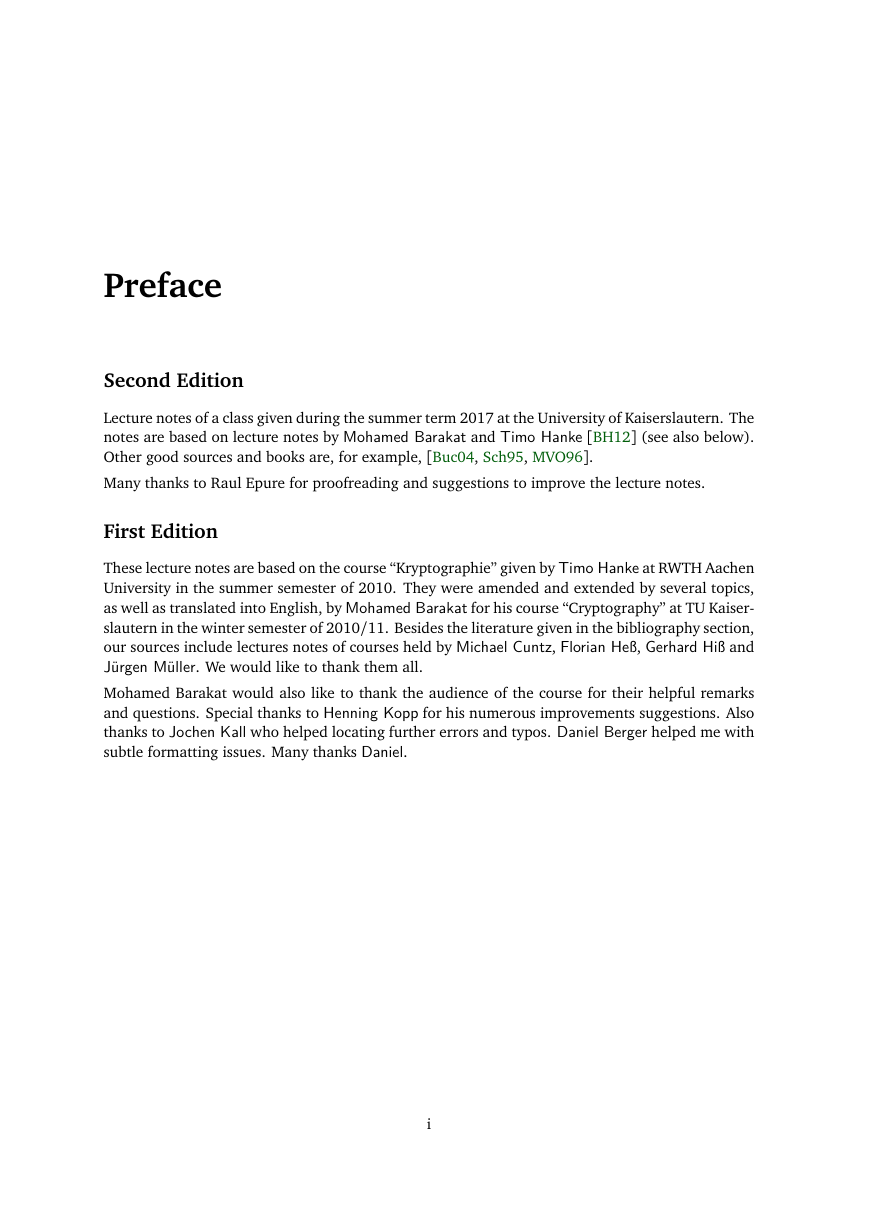
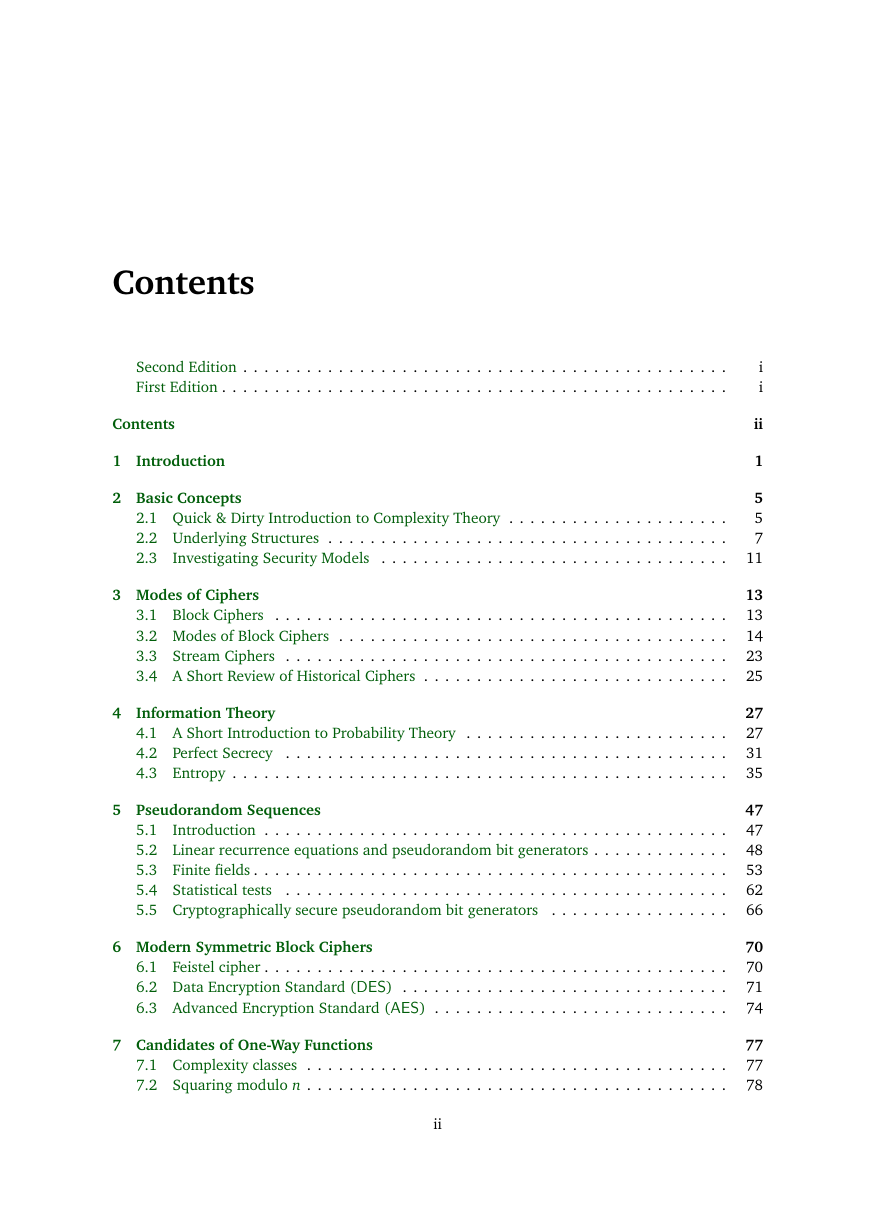
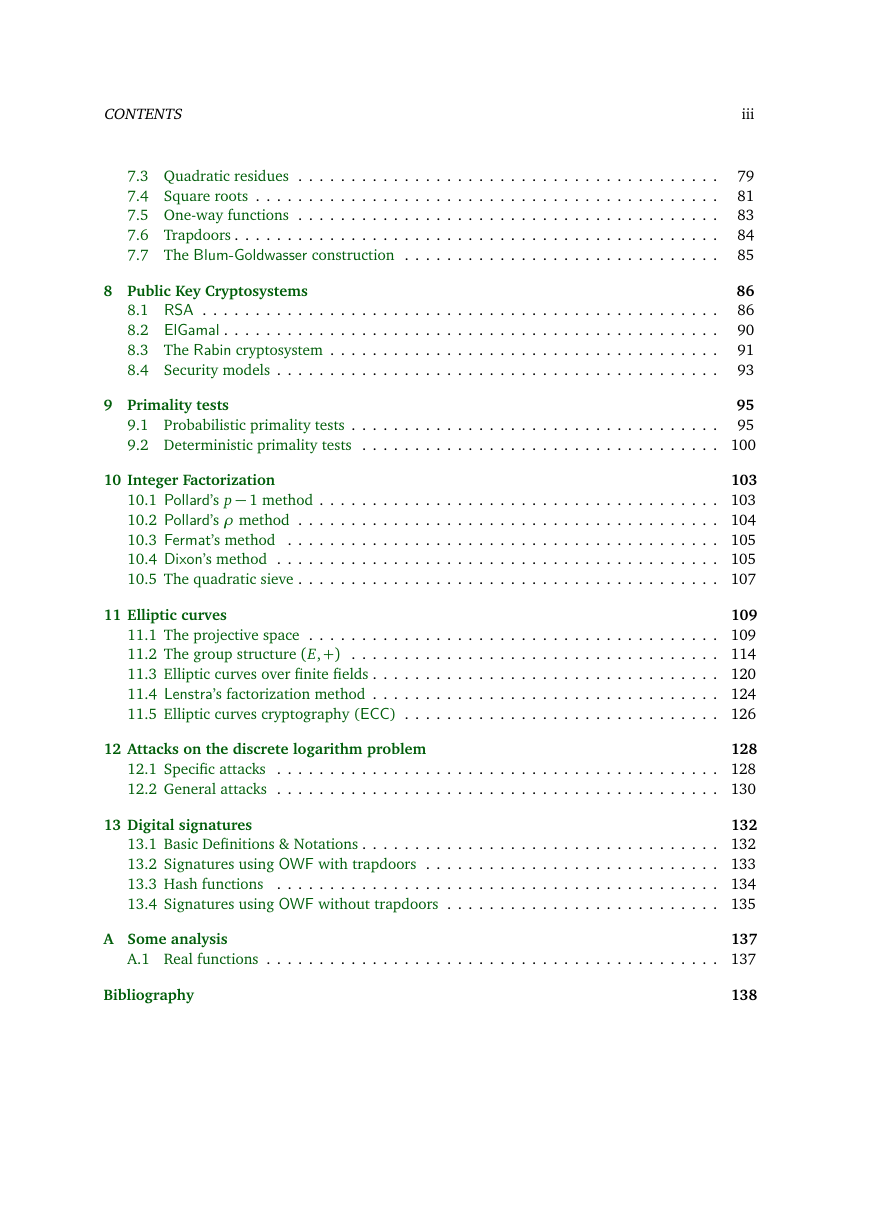

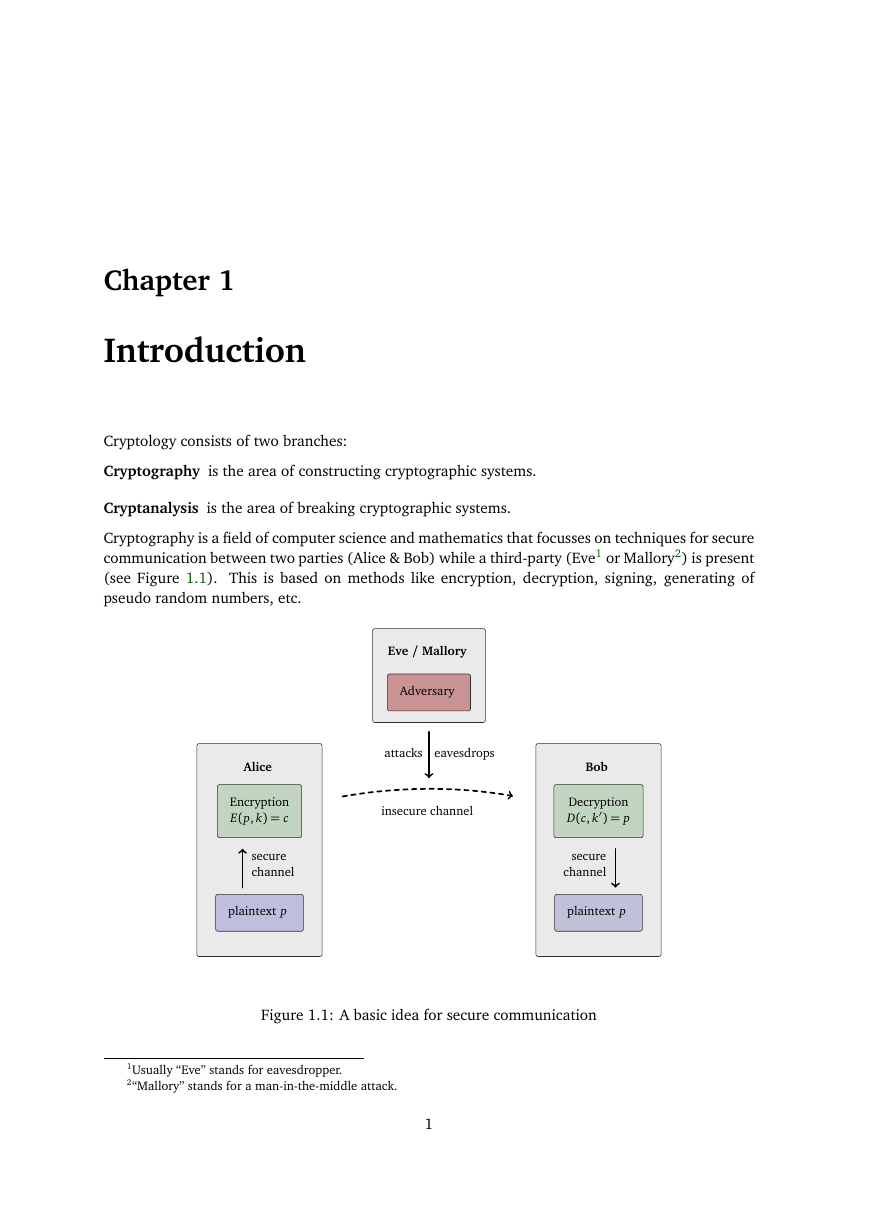
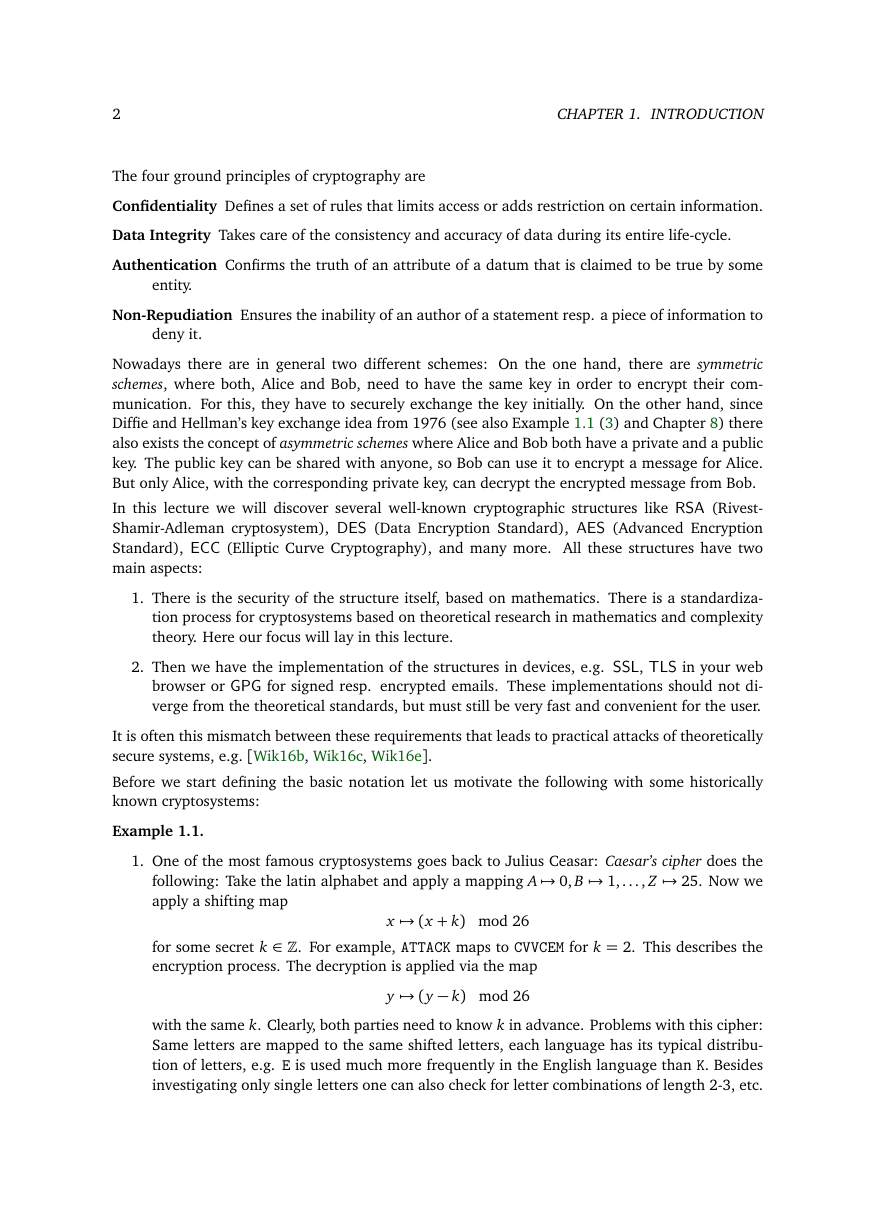








 2023年江西萍乡中考道德与法治真题及答案.doc
2023年江西萍乡中考道德与法治真题及答案.doc 2012年重庆南川中考生物真题及答案.doc
2012年重庆南川中考生物真题及答案.doc 2013年江西师范大学地理学综合及文艺理论基础考研真题.doc
2013年江西师范大学地理学综合及文艺理论基础考研真题.doc 2020年四川甘孜小升初语文真题及答案I卷.doc
2020年四川甘孜小升初语文真题及答案I卷.doc 2020年注册岩土工程师专业基础考试真题及答案.doc
2020年注册岩土工程师专业基础考试真题及答案.doc 2023-2024学年福建省厦门市九年级上学期数学月考试题及答案.doc
2023-2024学年福建省厦门市九年级上学期数学月考试题及答案.doc 2021-2022学年辽宁省沈阳市大东区九年级上学期语文期末试题及答案.doc
2021-2022学年辽宁省沈阳市大东区九年级上学期语文期末试题及答案.doc 2022-2023学年北京东城区初三第一学期物理期末试卷及答案.doc
2022-2023学年北京东城区初三第一学期物理期末试卷及答案.doc 2018上半年江西教师资格初中地理学科知识与教学能力真题及答案.doc
2018上半年江西教师资格初中地理学科知识与教学能力真题及答案.doc 2012年河北国家公务员申论考试真题及答案-省级.doc
2012年河北国家公务员申论考试真题及答案-省级.doc 2020-2021学年江苏省扬州市江都区邵樊片九年级上学期数学第一次质量检测试题及答案.doc
2020-2021学年江苏省扬州市江都区邵樊片九年级上学期数学第一次质量检测试题及答案.doc 2022下半年黑龙江教师资格证中学综合素质真题及答案.doc
2022下半年黑龙江教师资格证中学综合素质真题及答案.doc